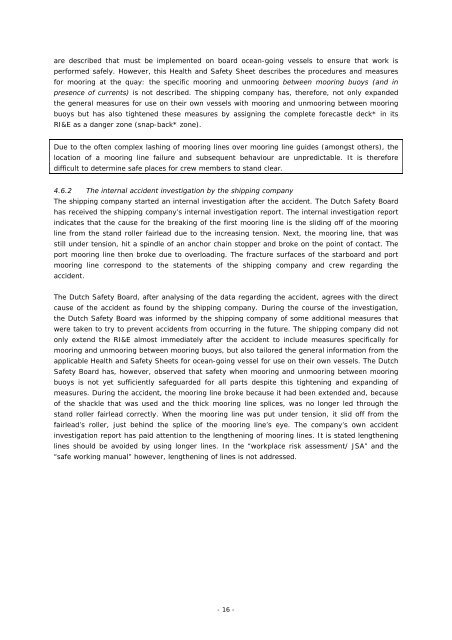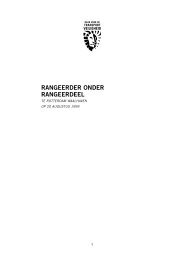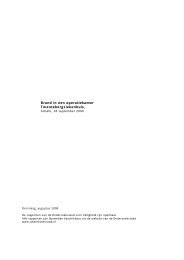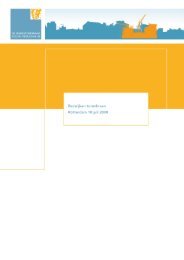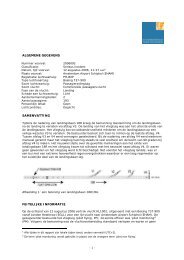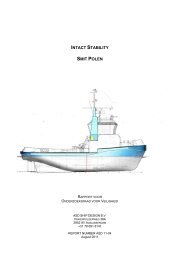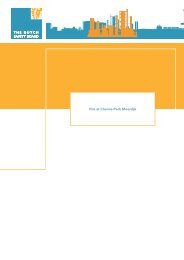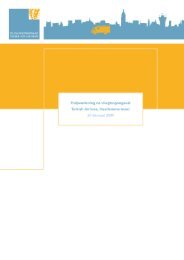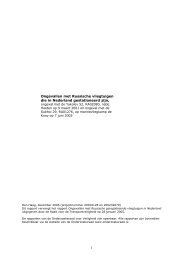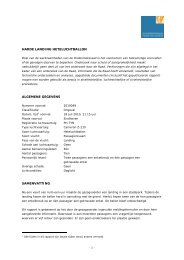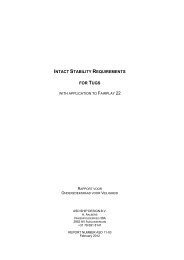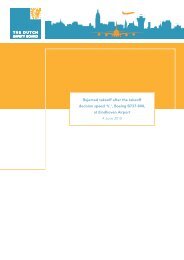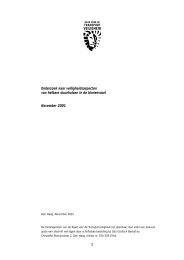Breaking of mooring lines whilst mooring m.v. Edisongracht between ...
Breaking of mooring lines whilst mooring m.v. Edisongracht between ...
Breaking of mooring lines whilst mooring m.v. Edisongracht between ...
You also want an ePaper? Increase the reach of your titles
YUMPU automatically turns print PDFs into web optimized ePapers that Google loves.
are described that must be implemented on board ocean-going vessels to ensure that work isperformed safely. However, this Health and Safety Sheet describes the procedures and measuresfor <strong>mooring</strong> at the quay: the specific <strong>mooring</strong> and un<strong>mooring</strong> <strong>between</strong> <strong>mooring</strong> buoys (and inpresence <strong>of</strong> currents) is not described. The shipping company has, therefore, not only expandedthe general measures for use on their own vessels with <strong>mooring</strong> and un<strong>mooring</strong> <strong>between</strong> <strong>mooring</strong>buoys but has also tightened these measures by assigning the complete forecastle deck* in itsRI&E as a danger zone (snap-back* zone).Due to the <strong>of</strong>ten complex lashing <strong>of</strong> <strong>mooring</strong> <strong>lines</strong> over <strong>mooring</strong> line guides (amongst others), thelocation <strong>of</strong> a <strong>mooring</strong> line failure and subsequent behaviour are unpredictable. It is thereforedifficult to determine safe places for crew members to stand clear.4.6.2 The internal accident investigation by the shipping companyThe shipping company started an internal investigation after the accident. The Dutch Safety Boardhas received the shipping company’s internal investigation report. The internal investigation reportindicates that the cause for the breaking <strong>of</strong> the first <strong>mooring</strong> line is the sliding <strong>of</strong>f <strong>of</strong> the <strong>mooring</strong>line from the stand roller fairlead due to the increasing tension. Next, the <strong>mooring</strong> line, that wasstill under tension, hit a spindle <strong>of</strong> an anchor chain stopper and broke on the point <strong>of</strong> contact. Theport <strong>mooring</strong> line then broke due to overloading. The fracture surfaces <strong>of</strong> the starboard and port<strong>mooring</strong> line correspond to the statements <strong>of</strong> the shipping company and crew regarding theaccident.The Dutch Safety Board, after analysing <strong>of</strong> the data regarding the accident, agrees with the directcause <strong>of</strong> the accident as found by the shipping company. During the course <strong>of</strong> the investigation,the Dutch Safety Board was informed by the shipping company <strong>of</strong> some additional measures thatwere taken to try to prevent accidents from occurring in the future. The shipping company did notonly extend the RI&E almost immediately after the accident to include measures specifically for<strong>mooring</strong> and un<strong>mooring</strong> <strong>between</strong> <strong>mooring</strong> buoys, but also tailored the general information from theapplicable Health and Safety Sheets for ocean-going vessel for use on their own vessels. The DutchSafety Board has, however, observed that safety when <strong>mooring</strong> and un<strong>mooring</strong> <strong>between</strong> <strong>mooring</strong>buoys is not yet sufficiently safeguarded for all parts despite this tightening and expanding <strong>of</strong>measures. During the accident, the <strong>mooring</strong> line broke because it had been extended and, because<strong>of</strong> the shackle that was used and the thick <strong>mooring</strong> line splices, was no longer led through thestand roller fairlead correctly. When the <strong>mooring</strong> line was put under tension, it slid <strong>of</strong>f from thefairlead’s roller, just behind the splice <strong>of</strong> the <strong>mooring</strong> line’s eye. The company’s own accidentinvestigation report has paid attention to the lengthening <strong>of</strong> <strong>mooring</strong> <strong>lines</strong>. It is stated lengthening<strong>lines</strong> should be avoided by using longer <strong>lines</strong>. In the “workplace risk assessment/ JSA” and the“safe working manual” however, lengthening <strong>of</strong> <strong>lines</strong> is not addressed.- 16 -


